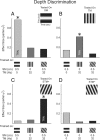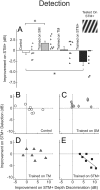Perceptual learning evidence for tuning to spectrotemporal modulation in the human auditory system
- PMID: 22573676
- PMCID: PMC3519395
- DOI: 10.1523/JNEUROSCI.5732-11.2012
Perceptual learning evidence for tuning to spectrotemporal modulation in the human auditory system
Abstract
Natural sounds are characterized by complex patterns of sound intensity distributed across both frequency (spectral modulation) and time (temporal modulation). Perception of these patterns has been proposed to depend on a bank of modulation filters, each tuned to a unique combination of a spectral and a temporal modulation frequency. There is considerable physiological evidence for such combined spectrotemporal tuning. However, direct behavioral evidence is lacking. Here we examined the processing of spectrotemporal modulation behaviorally using a perceptual-learning paradigm. We trained human listeners for ∼1 h/d for 7 d to discriminate the depth of spectral (0.5 cyc/oct; 0 Hz), temporal (0 cyc/oct; 32 Hz), or upward spectrotemporal (0.5 cyc/oct; 32 Hz) modulation. Each trained group learned more on their respective trained condition than did controls who received no training. Critically, this depth-discrimination learning did not generalize to the trained stimuli of the other groups or to downward spectrotemporal (0.5 cyc/oct; -32 Hz) modulation. Learning on discrimination also led to worsening on modulation detection, but only when the same spectrotemporal modulation was used for both tasks. Thus, these influences of training were specific to the trained combination of spectral and temporal modulation frequencies, even when the trained and untrained stimuli had one modulation frequency in common. This specificity indicates that training modified circuitry that had combined spectrotemporal tuning, and therefore that circuits with such tuning can influence perception. These results are consistent with the possibility that the auditory system analyzes sounds through filters tuned to combined spectrotemporal modulation.
Figures






Similar articles
-
Perceptual-learning evidence for separate processing of asynchrony and order tasks.J Neurosci. 2006 Dec 6;26(49):12708-16. doi: 10.1523/JNEUROSCI.2254-06.2006. J Neurosci. 2006. PMID: 17151274 Free PMC article.
-
Perceptual learning of auditory spectral modulation detection.Exp Brain Res. 2012 May;218(4):567-77. doi: 10.1007/s00221-012-3049-0. Epub 2012 Mar 15. Exp Brain Res. 2012. PMID: 22418781 Free PMC article.
-
Spectral plasticity in monkey primary auditory cortex limits performance generalization in a temporal discrimination task.J Neurophysiol. 2020 Dec 1;124(6):1798-1814. doi: 10.1152/jn.00278.2020. Epub 2020 Sep 30. J Neurophysiol. 2020. PMID: 32997564 Free PMC article.
-
Auditory perceptual learning and changes in the conceptualization of auditory cortex.Hear Res. 2018 Sep;366:3-16. doi: 10.1016/j.heares.2018.03.011. Epub 2018 Mar 12. Hear Res. 2018. PMID: 29551308 Review.
-
Active listening: task-dependent plasticity of spectrotemporal receptive fields in primary auditory cortex.Hear Res. 2005 Aug;206(1-2):159-76. doi: 10.1016/j.heares.2005.01.015. Hear Res. 2005. PMID: 16081006 Review.
Cited by
-
Dynamic Reweighting of Auditory Modulation Filters.PLoS Comput Biol. 2016 Jul 11;12(7):e1005019. doi: 10.1371/journal.pcbi.1005019. eCollection 2016 Jul. PLoS Comput Biol. 2016. PMID: 27398600 Free PMC article.
-
Learning, worsening, and generalization in response to auditory perceptual training during adolescence.J Acoust Soc Am. 2013 Aug;134(2):1172-82. doi: 10.1121/1.4812258. J Acoust Soc Am. 2013. PMID: 23927116 Free PMC article.
-
Auditory sensitivity to spectral modulation phase reversal as a function of modulation depth.PLoS One. 2018 Apr 5;13(4):e0195686. doi: 10.1371/journal.pone.0195686. eCollection 2018. PLoS One. 2018. PMID: 29621338 Free PMC article.
-
Different patterns of perceptual learning on spectral modulation detection between older hearing-impaired and younger normal-hearing adults.J Assoc Res Otolaryngol. 2013 Apr;14(2):283-94. doi: 10.1007/s10162-012-0363-y. Epub 2012 Dec 11. J Assoc Res Otolaryngol. 2013. PMID: 23229719 Free PMC article.
-
Immersive audiomotor game play enhances neural and perceptual salience of weak signals in noise.Proc Natl Acad Sci U S A. 2014 Jun 24;111(25):E2606-15. doi: 10.1073/pnas.1322184111. Epub 2014 Jun 9. Proc Natl Acad Sci U S A. 2014. PMID: 24927596 Free PMC article. Clinical Trial.
References
-
- Ahissar M, Hochstein S. The reverse hierarchy theory of visual perceptual learning. Trends Cogn Sci. 2004;8:457–464. - PubMed
-
- ANSI. American national standards specification for audiometers. New York: American National Standards Institute; 2004.
-
- Bacon SP, Grantham DW. Modulation masking: effects of modulation frequency, depth, and phase. J Acoust Soc Am. 1989;85:2575–2580. - PubMed
-
- Bregman A. Auditory scene analysis: the perceptual organization of sound. Cambridge, MA: MIT; 1990.
-
- Carlyon RP, Shamma S. An account of monaural phase sensitivity. J Acoust Soc Am. 2003;114:333–348. - PubMed
Publication types
MeSH terms
Grants and funding
LinkOut - more resources
Full Text Sources
Medical
